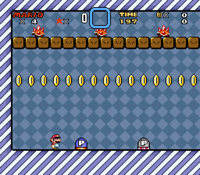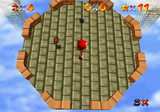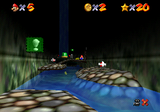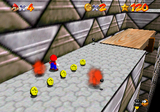Switch Palace: Difference between revisions
No edit summary |
|||
| Line 1: | Line 1: | ||
[[File:Blue Switch Palace.png|thumb|The [[Blue Switch Palace]], a Switch Palace in ''Super Mario World'']] | [[File:Blue Switch Palace.png|thumb|The [[Blue Switch Palace]], a Switch Palace in ''Super Mario World'']] | ||
{{quote|The power of the switch you have pushed will turn [[File:SMW Yellow Dotted Line Block.png|alt=yellow Dotted Line Block|link=Dotted-Line Block]] into [[File:SMW Yellow Exclamation Mark Block.png|alt=yellow Exclamation Mark Block|link=! Block]].|[[Yellow Switch Palace]] message|[[Super Mario World]]}} | {{quote|The power of the switch you have pushed will turn [[File:SMW Yellow Dotted Line Block.png|alt=yellow Dotted Line Block|link=Dotted-Line Block]] into [[File:SMW Yellow Exclamation Mark Block.png|alt=yellow Exclamation Mark Block|link=! Block]].|[[Yellow Switch Palace]] message|[[Super Mario World]]}} | ||
A '''Switch Palace'''<ref>''Super Mario World'' | A '''Switch Palace'''<ref>{{cite|date=1991|language=en|title=''Super Mario World'' instruction booklet|publisher=Nintendo of America|page=21}}</ref> is a small [[level]] that features a [[! Switch]] (or [[? Switch]], in ''[[Super Mario 64 DS]]''). When hit, the switch turns [[Dotted-Line Block]]s of the same color into solid [[! Block]]s (or [[? Block]]s) throughout the game's other levels. In addition to becoming [[platform]]s, the ! Blocks may contain certain [[List of power-ups|power-ups]] or be empty, depending on the color and game. | ||
The music to the ''[[Super Mario World]]'' Switch Palace receives a rendition in ''[[Dance Dance Revolution: Mario Mix]]'', under the name "[[Step by Step]]." The composition combines elements of the [[Bonus game (Super Mario World)|bonus game]] from said game as well. | The music to the ''[[Super Mario World]]'' Switch Palace receives a rendition in ''[[Dance Dance Revolution: Mario Mix]]'', under the name "[[Step by Step]]." The composition combines elements of the [[Bonus game (Super Mario World)|bonus game]] from said game as well. | ||
| Line 9: | Line 9: | ||
===''Super Mario World'' / ''Super Mario World: Super Mario Advance 2''=== | ===''Super Mario World'' / ''Super Mario World: Super Mario Advance 2''=== | ||
There are four Switch Palaces in ''Super Mario World'' and its [[reissue]], ''[[Super Mario World: Super Mario Advance 2]]''. Each one contains a bonus room where at least one [[extra life]] can be earned and a hall with the big switch. Hitting it clears the level, and the Switch Palace [[Unrevisitable area|cannot be played again]], indicated by its [[world]] map icon also becoming pressed. Switch Palaces are usually unlocked from the secret exit of an adjacent level; the exception is the [[Yellow Switch Palace]], whose [[Yoshi's Island 1|previous level]] has only one exit. | There are four Switch Palaces in ''Super Mario World'' and its [[reissue]], ''[[Super Mario World: Super Mario Advance 2]]''. Each one contains a bonus room where at least one [[extra life]] can be earned and a hall with the big switch. Hitting it clears the level, and the Switch Palace [[Unrevisitable area|cannot be played again]], indicated by its [[world]] map icon also becoming pressed. Switch Palaces are usually unlocked from the secret exit of an adjacent level; the exception is the [[Yellow Switch Palace]], whose [[Yoshi's Island 1|previous level]] has only one exit. | ||
{|style=" | {|style="width:100%" class=wikitable | ||
|- | |- | ||
!colspan="2" width="1%" style="text-align:center;"|Big switch | !colspan="2" width="1%" style="text-align:center;"|Big switch | ||
| Line 45: | Line 45: | ||
===''Super Mario 64'' / ''Super Mario 64 DS''=== | ===''Super Mario 64'' / ''Super Mario 64 DS''=== | ||
In ''[[Super Mario 64]]'', the three locations containing the [[Cap Switch]]es are called Switch Palaces in the German localization and certain English coverage.<ref>''Official UK Nintendo Magazine'' Issue #56 | In ''[[Super Mario 64]]'', the three locations containing the [[Cap Switch]]es are called Switch Palaces in the German localization and certain English coverage.<ref>{{cite|publisher=EMAP|language=en-gb|title=''Official UK Nintendo Magazine'' Issue #56|date=May 1997|page=45}}</ref><ref>{{cite|title=''Ultimate Nintendo 64 Pocket Power Guide, 1999 Edition'' Prima's Official Strategy Guide|page=59|date=April 21, 1999|author=Prima Bath|publisher=Prima Games|isbn=0-7615-2083-X}}</ref> The [[Tower of the Wing Cap]], the [[Behind the Waterfall|Cavern of the Metal Cap]], and [[The Secret Under the Moat|Vanish Cap Under the Moat]] are respectively called the Red, Green, and Blue Switch Palaces. Whereas yellow and green ! Blocks in ''Super Mario World'' contain extra power-ups that appear elsewhere, each color of ! Block in ''Super Mario 64'' is the sole means of accessing a corresponding [[cap]] power-up. Accordingly, the Cap Switch courses are themed around their respective power-ups. [[Mario]] starts a Cap Switch course with the power of its cap and can get a [[Power Star]] by collecting [[Red Coin]]s with the use of the power-up. | ||
''Super Mario 64 DS'' removes all but one of the switches: The caps' abilities are allocated to the four playable characters through the [[Power Flower (Super Mario 64 DS)|Power Flower]] and [[Wing Cap|Wings]], both of which the ? Switch unlocks. The two courses whose Cap Switches were removed are renamed, and an extra Power Star is added to them. | ''Super Mario 64 DS'' removes all but one of the switches: The caps' abilities are allocated to the four playable characters through the [[Power Flower (Super Mario 64 DS)|Power Flower]] and [[Wing Cap|Wings]], both of which the ? Switch unlocks. The two courses whose Cap Switches were removed are renamed, and an extra Power Star is added to them. | ||
{|style=" | {|style="width:100%" class=wikitable | ||
|- | |- | ||
!width="1%" style="text-align:center;"|Image | !width="1%" style="text-align:center;"|Image | ||
Revision as of 13:25, August 18, 2024

- “The power of the switch you have pushed will turn
 into
into  .”
.” - —Yellow Switch Palace message, Super Mario World
A Switch Palace[1] is a small level that features a ! Switch (or ? Switch, in Super Mario 64 DS). When hit, the switch turns Dotted-Line Blocks of the same color into solid ! Blocks (or ? Blocks) throughout the game's other levels. In addition to becoming platforms, the ! Blocks may contain certain power-ups or be empty, depending on the color and game.
The music to the Super Mario World Switch Palace receives a rendition in Dance Dance Revolution: Mario Mix, under the name "Step by Step." The composition combines elements of the bonus game from said game as well.
History
Super Mario World / Super Mario World: Super Mario Advance 2
There are four Switch Palaces in Super Mario World and its reissue, Super Mario World: Super Mario Advance 2. Each one contains a bonus room where at least one extra life can be earned and a hall with the big switch. Hitting it clears the level, and the Switch Palace cannot be played again, indicated by its world map icon also becoming pressed. Switch Palaces are usually unlocked from the secret exit of an adjacent level; the exception is the Yellow Switch Palace, whose previous level has only one exit.
| Big switch | Switch Palace | World | Means of access | |
|---|---|---|---|---|
| SNES | GBA | |||
| Yellow Switch Palace | Yoshi's Island | Beat Yoshi's Island 1. | ||
| Green Switch Palace | Donut Plains | Find Donut Plains 2's secret exit via keyhole. | ||
| Red Switch Palace | Vanilla Dome | Find Vanilla Dome 2's secret exit via keyhole. | ||
| Blue Switch Palace | Forest of Illusion | Find Forest of Illusion 2's secret exit via keyhole. | ||
Super Mario 64 / Super Mario 64 DS
In Super Mario 64, the three locations containing the Cap Switches are called Switch Palaces in the German localization and certain English coverage.[2][3] The Tower of the Wing Cap, the Cavern of the Metal Cap, and Vanish Cap Under the Moat are respectively called the Red, Green, and Blue Switch Palaces. Whereas yellow and green ! Blocks in Super Mario World contain extra power-ups that appear elsewhere, each color of ! Block in Super Mario 64 is the sole means of accessing a corresponding cap power-up. Accordingly, the Cap Switch courses are themed around their respective power-ups. Mario starts a Cap Switch course with the power of its cap and can get a Power Star by collecting Red Coins with the use of the power-up.
Super Mario 64 DS removes all but one of the switches: The caps' abilities are allocated to the four playable characters through the Power Flower and Wings, both of which the ? Switch unlocks. The two courses whose Cap Switches were removed are renamed, and an extra Power Star is added to them.
| Image | Course | Power-up | Means of access |
|---|---|---|---|

|
Tower of the Wing Cap (Super Mario 64)? Switch (Super Mario 64 DS) | Wing Cap (Super Mario 64)Power Flower or Wings (Super Mario 64 DS) | Collect ten Power Stars (14 in Super Mario 64 DS), stand on the rug in the center of the Mushroom Castle's foyer, and use the first-person camera mode to look up at the source of the beam of light. |

|
Cavern of the Metal Cap (Super Mario 64)Behind the Waterfall (Super Mario 64 DS) | Metal Cap (Super Mario 64)None (Super Mario 64 DS) | In the Underground Lake in the Hazy Maze Cave, steer Dorrie to reach the double doors, and fall into the pool of rippling metal in the next room. |

|
Vanish Cap Under the Moat (Super Mario 64)The Secret Under the Moat (Super Mario 64 DS) | Vanish Cap (Super Mario 64)None (Super Mario 64 DS) | Ground-pound two brick pillars in the Mushroom Castle's basement, then fall down a hole in the drained moat. |
Names in other languages
| Language | Name | Meaning | Notes |
|---|---|---|---|
| French | Palais Bloc[?] | Block Palace | |
| German | Schalterpalast[?] | Switch Palace | |
| Italian | Palazzo dell'interruttore (Super Mario Bros. Encyclopedia)[?] | Palace of the Switch | |
| Portuguese | Palácio de Transformação[?] | Transformation Palace | |
| Spanish | Palacio del Interruptor[?] | Switch Palace |
References
- ^ 1991. Super Mario World instruction booklet. Nintendo of America (English). Page 21.
- ^ May 1997. Official UK Nintendo Magazine Issue #56. EMAP (British English). Page 45.
- ^ Prima Bath (April 21, 1999). Ultimate Nintendo 64 Pocket Power Guide, 1999 Edition Prima's Official Strategy Guide. Prima Games. ISBN 0-7615-2083-X. Page 59.
- ^ Super Mario World Japanese instruction booklet (fold-out)